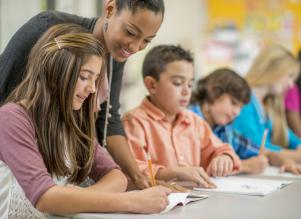4/18/2018
How to Boost Adolescent Literacy: Tap into Student Interest
Many students today lack essential literacy skills. Indeed, a panel of education experts gathered by the group All About Adolescent Literacy noted that many students—especially those in high-poverty schools—reach high school with underdeveloped reading skills. These students can often read words, but lack the ability to adequately comprehend more advanced, academic writing. This is a problem that negatively impacts graduation and dropout rates, and also yields future productivity concerns.
According to panelist and former high school principal Dr. Mel Riddle, one problem is the tendency for schools to stop teaching reading after third grade. Once a child has the fundamentals down, Dr. Riddle argued, many schools step back from explicit reading instruction—sometimes creating a situation in which a student’s literacy skills do not adequately advance. Comprehension then wanes, leading to high school students who struggle to keep pace with their more advanced peers.
While there are many strategies available to help teachers address this skills gap, has putting students’ interests at the center of this work been overlooked? Innovative approaches can boost the reading, writing, and comprehension levels of adolescents, while also helping them stay more engaged in school. Two approaches that focus on using sports and the arts as a gateway to improved literacy outcomes may be worth a closer look.
Sports as inspiration
A new program at California State University, Fullerton uses students’ natural love of sports as a jumping-off point for engaging them with literacy. The program is called REACH, which stands for Reflective Educational Approach to Character and Health. Through this program, professors and undergraduate students at CSU work with a local community center to provide kids with opportunities to play sports, such as soccer, and then pair the physical activity with reading, writing, and reflection.
The students read books such as “Booked” by Kwame Alexander, which offers a fictional take on a young soccer player’s character development, and then “write about their goals for school, what they did this week, incidents that happened and how those things affected or changed them,” in the words of program supervisor Risto Marttinen. This approach follows some basic yet important advice for keeping young people engaged in reading: Make it relevant to their lives. “Adolescents like to read books with characters that are facing similar teen-related challenges in their lives,” Jennifer Chung reminded readers in a 2015 "Orlando Sun-Sentinel" parenting column.
Focusing on art can work, too
For many students, the path to a greater love of reading is through sports, but for others, the arts offer the strongest draw. Recently, state education officials in Utah dropped a slew of course requirements for middle school students, including music, visual arts, and digital literacy classes. The rationale was a stated desire to provide more “flexibility and local control” to schools, which could then feasibly create their own requirements. Public outcry, however, led to a pause on this decision, as parents and students rallied to have art classes reinstated.
Citing this outcry, an editorial in the "Deseret News" argued that, in the push to improve educational outcomes, the state “must not neglect the arts.” The editorial noted that “Numerous studies link rigorous adolescent engagement with music, theater, or other art forms with improved reading comprehension” and other academic skills, making such areas of study vital to K-12 education. Students, it seems, do not necessarily learn to read well through direct instruction alone.
In this vein, Eileen Landay and Kurt Wooten—both professors at Brown University—developed the ArtsLiteracy Project to help middle and high school educators teach literacy through the arts. In an online interview, Landay described a time when she observed a high school classroom full of mostly disengaged young people. The students had been together for months but “remained virtual strangers,” Landay noted, causing the room to seem “socially and academically asleep.”
Landay and Wooten contended that the students needed a reason to learn and to be at school, and that purpose came through interdisciplinary lessons rooted in student engagement. The professors documented this model in their book, “A Reason to Read: Linking Literacy and the Arts.” The book walks teachers through the process of first building community in the classroom, then introducing students to high-quality texts before helping them engage with the material and create their own texts. The goal is to “wake them up” through greater collaboration with adults (including, ideally, visiting artists) and their fellow students—all with the intention of improving their literacy skills.
Many experts have zeroed in on the critical need to address adolescent literacy before another generation of students either drops out of high school or graduates lacking essential skills. While explicit literacy instruction is important, maintaining student interest through channels such as sports or the arts can also help students learn to read and write well and with purpose.


